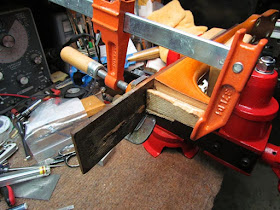I have a couple of small things to attend to before I can begin the neck reset on the Regal. Better to take care of them now rather than later.
First, I cleaned up the dovetail. You may recall there were bits of shims on the male part.
A couple passes with a chisel takes care of it.
I recently sharpened all of my chisels and now they're ready to go. I have read that it takes a while to get the hang of sharpening tools such as these. I'm getting a lot better.
I've also read that the test for 'scary sharp' is being able to cut the hairs on your arm (if you have hairs on your arm). Yes, the chisels passed that test!
The other part of the joint on the guitar is really ugly. More chiseling/cleanup ensues.
It looks to me as if the dovetail was a bit rough, and Regal just depended on shims to make a tight joint.
I'll be interested to see if my May Bell guitar looks the same.
The dovetail after the cleanup.
Looks better I think.
I've already scouted The Dungeon for new shims. I found a small hunk of maple that should work well when it's cut up into shim-shape.
So I spotted this crack on the edge of the fingerboard. I don't know if this was already there or if it happened during the neck removal. I suspect it was an old crack which got worse.
In any event, I need to glue it up.
Another repair is on the neck heel.
The green arrow points to a corner of the dovetail that's cracked. I want to save that piece, so I'll inject some glue in the crack.
The blue arrow points to separation between the dovetail and the fingerboard. You'll see this a fair amount when you take a neck off - usually the steam and use of the separation knife will open this joint up. Just a side effect of using steam to get the neck off.
Not a big thing, and easy to fix.
I cooked up a fresh batch of hide glue. This time I'm using some that is 196 gram strength - I had been using 164 previously (and still have some of that). The 196 will set a bit faster. And I really just wanted to try something new!
We inject the hot glue into the crack with a 0.7mm needle on the syringe. I gently pushed the end of the fingerboard down to help open the crack.
You can see the glue squeezing out of the crack - this ensures the joint will have the proper amount of glue in it. The excess wipes up easily with a hot, damp rag. (I just dip it in the water I'm using to heat the glue jar in).
Quickly clamp it up with a caul and a small c-clamp. Use a caul on the fingerboard side unless you want to put a round divot in the board.
You can see the repaired crack will be almost invisible.
That clamp, by the way is quite small - it's only about 1.5 inches (maybe 37mm) across. The wide angle lens on the camera makes it look huge! I bought the clamp at a yard sale for 10 cents. I probably should dunk it in Naval Jelly to de-rust it, but it works fine as is.
Next up, I inject the seam between the dovetail and fingerboard the same way. And I got that small piece I mentioned earlier glued as well.
I really like injecting the glue this way. Lots of fun!
You need to work quickly before the hide glue begins to gel. It's heated to about 140 degrees F and will gel when it cools to about 90.
But I had time to take this quick shot of the joint before I clamped it up. Notice the glue coming out of the joint - A Good Thing.
Again, you can give it a quick wipe with a damp rag to get up the excess. Any that's left after the glue dries will come up easily with a hot rag and a bit of scraping.
Isn't hide glue wonderful?
Another caul on the fingerboard and we clamp the joint down tight.
After these 2 repairs dry, I have a couple more to work on.










No comments:
Post a Comment